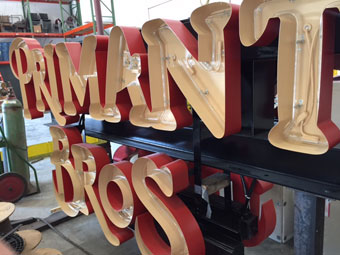City Neon, Inc., has been around since the 1950s, and in that time, the shop has seen many lighting trends come and go.
Today the company handles mostly LED projects, but they still get requests for the occasional large neon project—such as the one they’ve been working on for Primanti Bros., a chain of sandwich shops based out of Pittsburgh, Pennsylvania.
The chain has recently expanded to new locations in the Pennsylvania and Ohio area, and it wanted to maintain the original look it had when it opened over fifty years ago.
City Neon worked to provide the signage for over ten new locations, including a pylon sign, three wall signs, and one sandwich logo for each new restaurant.
That adds up to a lot of red neon that City Neon had to bend in-house.
In fact, the hardest part of the fabrication was keeping up with the magnitude of work. So when the shop had signs due at the same time for two locations, logistics won out.
“One project is about three weeks of neon. So two projects at once due in five weeks was just impossible for our neon guy to do,” says Chris Atkins, operations manager of City Neon. “So we ended up subbing half of one job out.”
Order #1: Pylon Signs
The new locations include eighteen- to thirty-foot-tall pylon signs with open-face red neon channel letters. The lone exception is the York, Pennsylvania location, which features an eighty-foot-tall pylon sign.
City Neon fabricated the backs of the channel letters from aluminum using its Gerber Sabre™ router.
With the Super ChannelBender from AdamsTech, the shop bent the channel letter sides.

City Neon used a Norlok machine to attach the sides to the back. This “clinching” method of attachment cuts back on waste because it punches the metal into itself without the need for other fasteners.
For the main portion of the pylon sign, Primanti Bros. wanted to maintain a very particular look.
“They try to stay with an I-beam, industrial look to maintain the Pittsburgh, ‘steel city’ kind of thing,” says Atkins. “What we did to keep that look was use an I-beam, but it’s kind of hard to mount channel letters to an I-beam.”
So their solution was to build a raceway to house inside of the I-beam. The SignComp raceway is hingeable and attaches to the I-beam. It houses all of the wiring and power supplies, which made adding the channel letters later easier.
Order #2: Wall Cabinets
Each restaurant received three illuminated wall cabinets, which ranged in size from four to five feet tall and ten to twenty-two feet long.
The cabinets are made from aluminum square tubing and angle, as well as four-by-eight sheets of aluminum that was all welded together. SignComp extrusions were added to the sides for an even more dimensional look.
The cabinets were painted with a combination of Matthews Paint and AkzoNobel’s GRIP-GARD® paints. “We painted it, stenciled it with vinyl, and then painted it again to give it two colors,” explains Atkins.
The neon lettering that had been bent in-house was attached to the cabinets with tube supports.
Meanwhile the transformers and wiring were housed inside the cabinets.
Order #3: Sandwich Logos

For the sandwich logo signs, City Neon digitally printed the image on an ACM panel using an Epson SureColor® S30670 printer. A neon ring runs around the panel and was attached with tube supports.
Order Up! Install
City Neon also installed all of the signage at the new locations.
For the pylon and wall cabinets, the shop used a modular build process that allowed them to install the pylon sign in four to six hours and the wall cabinets in two to three hours—with the wiring as well.
Each wall cabinet had 90-degree angle pieces with holes in them, and these pieces were used to mount the signs. (Note: Depending on the wall material, the cabinets were either bolted, lagged, or all threaded to the wall.)
The sandwich logo signs were screwed into the wall (using Tapcon® screws on the brick walls), and they took two to three hours to install (including wiring).
During the installations, City Neon used its Manitex SkyCrane SC62 to lift everything under thirty feet. For the eighty-foot pylon sign, the shop used its eighty-five-foot Elliott truck along with a crane rented from sister company City Crane.
One thing is for certain—this project definitely satiated City Neon’s craving for neon projects!
By Ashley Bray
All photos: City Neon, Inc.











